Joachim Wagner

Joachim Wagner (13 April 1690 – 23 May 1749) was an important Brandenburg organ builder.
Origin[edit]
Wagner was born as the son of the pastor Christoph Wagner (1653-1709) and his wife Anna Dorothea née Tiefenbach in Karow, Duchy of Magdeburg. His brothers, the pastors Johann Christoph Wagner (1683-1750, since 1710 his father's successor in office in Karow), and Friedrich Wagner (1693-1760), later had an influence on his work.
Work[edit]

It is possible that Wagner learned the organ building trade from Schnitger's student Matthäus Hartmann (died ca. 1745). Evidence shows that Christoph Treutmann the Elder (c. 1673-1757) in Magdeburg was Wagner's teacher.[1] As a journeyman, Wagner went on the road and also worked for Gottfried Silbermann in Freiberg for two years. He came to Berlin in 1719.[2] He completed his masterpiece there in 1723 with the organ in the St. Mary's Church, Berlin (already consecrated in 1721), which had three manuals and 40 stops. In Berlin, he also built his largest work with 50 stops on three manuals in the newly built Berliner Garnisonkirche between 1724 and 1726. (rebuilt in 1892, burned in 1908).
He was by far the most important organ builder of the Baroque period in the Margraviate of Brandenburg, as conditions were particularly favourable during the reign of the Soldier King Frederick William I of Prussia (1713-1740) offered favourable conditions for this. He is sometimes referred to as the "Märkischer Silbermann".
Wagner apparently died in Salzwedel while working on his last organ for the Marienkirche there at age 59, as it was completed by Gottlieb Scholtze.
Students[edit]
Among his pupils who continued his traditions were:[3]
- Matthias Kallensee, since 1720, later Werkmeister, died in 1741.
- Johann Peter Migendt, since 1731/32, since 1741 Werkmeister, took over the workshop in 1749 (c. 1703- 1767)
- Heinrich Andreas Contius, 1732 to about 1738, thereafter most important organ builder in the Baltic (1708- 1795)
- Georg Neumann, 1732-1742
- Gottlieb Scholtze, 1740/44 carving for Wagner, afterwards organ builder's pupil (c. 1713- c. 1782)
- Johann Gottlieb Mehnert, at the latest since 1746, afterwards organ builder in Stettin
- Ernst Julius Marx, possibly only with Migendt after 1749?, afterwards organ builder in Berlin
Organs[edit]
Sphere of influence[edit]
In the course of his life, Wagner built over 50 individually designed organs, both for large churches and for smaller village churches, of which 15 have been preserved in larger parts, as well as eight cases or smaller remnants.
From his workshop in Berlin, his sphere of activity extended mainly to the northern German Prussian Hohenzollern states, in addition to the residential cities of Berlin (8 organs) and Potsdam (4) and Brandenburg an der Havel (3) to the entire Margraviate of Brandenburg including Altmark (Werben (Elbe), Salzwedel), Uckermark (Angermünde, Gramzow, Schwedt/Oder) and Neumark (Königsberg), in Pomerania (Stargard, Wartin) and the Duchy of Magdeburg. But also in Kursachsen (Jüterbog) and Norway (Nidaros Cathedral in Trondheim) he built organs. Today, 15 organs with the largest original components have been preserved, the most valuable in the St. Peter and Paul Cathedral Brandenburg, as well as 8 cases or smaller remains.
Characteristics[edit]
Wagner built instruments that combined and further developed Central German and North German elements of organ building. However, the work principle cultivated in the baroque period of northern Germany was abandoned in favour of sound fusion and a single overall case. The sound characteristics include the powerful intonation, the well-staffed pedal keyboard (without pedal coupler), terceous mixtures and the manual transmissions built into some instruments.
In the course of his life he built over fifty individually designed organs, both for large churches and for small village churches, no two of which were completely alike. His casings were rich in variation, often bearing sculptural decoration and occasionally moving timpani and trumpet angels in the Silesian tradition, inspired by Johann Michael Röder.[2] All of these instruments are extremely valuable testimonies to a highly developed musical culture, which were also used by the musical greats of their time. On 8 May 1747, for example, Johann Sebastian Bach played the relatively small Wagner organ at Potsdam's Heilig-Geist-Kirche. The organ works of his son Carl Philipp Emanuel Bach were written in the context of the organ built in 1755 by Ernst Marx and Peter Migendt. house organ of the princess Anna Amalia, which is now located in Karlshorst.
Today's holdings[edit]
Fires, lack of maintenance as well as alterations resulting from the musical zeitgeist of the 19th century and the consequences of the Second World War have left only 15 more or less originally preserved instruments and eight other instrument remnants, mainly cases (some still with original stock). The Potsdam firm Alexander Schuke Potsdam Orgelbau has rendered great service to the restoration of Wagner organs in the course of its existence.
On 26 August 2006, the Joachim Wagner Society was founded in Rühstädt with the aim of researching and maintaining his unique heritage.
List of works[edit]
Today, 51 new organs, one disposition design, four conversions and some repairs are known from Wagner.[4] 15 organs in larger parts and eight pipe organs are preserved, some with small remains. The most important preserved one is located in the St. Peter and Paul Cathedral in Brandenburg.[5]
The size of the instruments is indicated in the fifth column by the number of manuals and the number of sounding stops in the sixth column. A capital P stands for an independent pedal, a small p for an attached pedal. An italicisation indicates that the organ in question is no longer preserved or that only the facade is still by Wagner.
| Year | Location | Building | Picture | Manual | Register | Notes |
|---|---|---|---|---|---|---|
| 1720–1723 | Berlin | St. Marien | 
|
III/P | 40 | Front and register preserved, interated in new building by Alfred Kern & fils (2002) |
| 1722–1723 | Potsdam | Old Garnisonkirche | II/P | 25 | Set up in the Jerusalemkirche, Berlin, in 1732; Dismantled around 1878 when the church was rebuilt; not preserved | |
| 1725 | Brandenburg an der Havel | Dom St. Peter und Paul |  |
II/P | 33 | Prospect, stops and pipes almost completely preserved in the original, largest preserved and functioning Wagner organ. → Orgel |
| 1724–1726 | Berlin | Garnisonkirche |  |
III/P | 50 | Not preserved |
| 1724–1726 | Berlin | Reithaus | II/P | 18 | Not preserved | |
| 1726–1727 | Blumberg | Dorfkirche | I | 7 | Not preserved | |
| 1726–1727 | Brandenburg an der Havel | St. Katharinen | 
|
III/P | 40 | Front preserved → Orgel |
| 172 | Berlin | St. Georgen | II/P | 16 | Not preserved | |
| 1727 | Berlin | Großes Friedrichs-Hospital, Waisenhauskirche | I/P | 9–10 | Not preserved | |
| 1728 | Bad Freienwalde (Oder) | St. Nikolai | 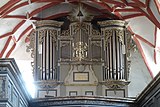
|
II/P | 24 | Façade preserved |
| 1729–1730 | Wriezen | St. Marien | III/P | 34 | Not preserved | |
| 1730 | Templin | Maria-Magdalenen-Kirche | II/P | 30 | Not preserved | |
| 1730 | Potsdam | Heilig-Geist-Kirche | II/P | 22 | Not preserved | |
| 1730–1731 | Stargard | Johanniskirche | II/P | 21 | Not preserved | |
| 1731 | Berlin | St. Gertraud, Hospitalkirche | I | 9 | Not preserved | |
| 1731–1732 | Berlin | Parochialkirche | II/P | 32 | Not preserved | |
| 1731–1732 | Potsdam | Garnisonkirche |  |
III/P | 42 | Not preserved |
| 1733 | Zehdenick | Stadtkirche Zehdenick | II/P | 18 | Not preserved | |
| 1732–1734 | Berlin-Spandau | St.-Nikolai-Kirche | II/P | 31 | Not preserved | |
| 1734 | Berlin | Französische Friedrichstadtkirche | I/P | 13 | Not preserved | |
| 1734–1735 | Altwriezen | Village church | I | 6 | Not preserved | |
| 1734–1736 | Königsberg in der Neumark | St. Marien | III | 45 | Not preserved | |
| 1735–1736 | Nahausen bei Königsberg in der Neumark | Village church | I | 7 | Not preserved | |
| 1735 | Schwedt/Oder | Schlosskapelle | I/P oder II/P | 15 oder 21 | Drafts from 19 September 1735, implementation unknown.[6][7][8] | |
| 1736 | Gramzow | Ev. Stadtkirche St. Marien | 
|
I/P | 9 | In the Dorfkirche Sternhagen since 1857, 2001-2009 restored and reconstructed by Alexander Schuke Potsdam Orgelbau[9] |
| ? um 1736 | Zachow (Czachów), Neumark | Dorfkirche | I | 7 | Side-playing parapet organ without pedal, rebuilt in 1837 by Buchholz with pedal, 1945 all metal pipes disappeared, 2003 discovery of Wagner authorship by Karl Richter, today empty facade with Buchholz pedal wood pipes preserved.[10][11] | |
| 1736–1737 | Brandenburg an der Havel | St. Gotthardt | II/P | 31 | Not preserved | |
| 1737 | Potsdam | Kirche des Militärwaisenhauses | 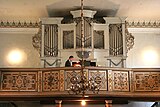
|
I | 8 | in the St. Marien in Pritzerbe since 1792.[12] |
| 1737 | Jüterbog | Liebfrauenkirche | 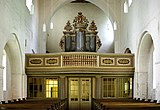
|
I/P | 13 | Largely preserved → Orgel |
| 1737–1738 | Bochow (Niedergörsdorf) | Village church | I/p | 7 oder 9 | Not preserved | |
| 1738 | Rühstädt | Dorfkirche | I/P | 10 | Casing and some stops preserved, rest reconstructed.[13] | |
| 1737–1739 | Brüssow | St. Sophia | I/P | 11 | Not preserved | |
| 1739 | Schönwalde | Dorfkirche | 
|
I/P | 12 | Preserved → Orgel |
| 1738–1740 | Magdeburg | Heilige-Geist-Kirche | III/P | 46 | Not preserved | |
| 1737–1741 | Jüterbog | St. Nikolai | 
|
II/P | 32 | The front has been preserved; it was built by J. Ch. Angermann from 1737 to 1741, as was the organ. Parts of the previous organ from 1602 were used in the construction of the organ. → Orgel.[14] |
| 1739–1741 | Treuenbrietzen | St. Marien | 
|
II/P | 30 | Preserved |
| 1739–1741 | Trondheim | Nidaros Cathedral | 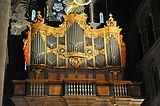
|
II/P | 30 | Restored in 1994 → Organ[15] |
| 1741 | Treuenbrietzen | St. Nikolai | I/P | 18? | Not preserved | |
| 1741 | Neuruppin | Sankt Marien | III/P | 42 | Not preserved | |
| 1742 | Wusterhausen/Dosse | St. Peter und Paul |  |
II/P | 29 | Redisposed several times; restored in 1978.[16] |
| 1741–1742 | Bötzow | St. Nikolai | I/P | 10 | Modified several times | |
| 1742–1744 | Angermünde | Stadtpfarrkirche St. Marien | 
|
II/P | 30 | Four timpani angels can be operated from the pedal. Painting of the facade in 1773; 1845 and 1899-1901 redispositions; 1967-1976 restoration in two sections by Schuke |
| 1743–1744 | Wartin | Ev. Kirche | I/P | 9 | durch Christian Friedrich Voit erweitert; zum großen Teil erhalten | |
| 1744–1745 | Gransee | St. Marien |  |
II/P | 21 | Front and some pipes preserved.[17] |
| 1744–1745 | Passow | Dorfkirche | I/P | 9 | Modified several times; Preserved casing and partial pipework | |
| 1744–1745 | ? | ? | II | 12 | only preserved Transmission organ Wagner's, original location unknown; since 1802/03 in Warsaw, church of St. Benon, from 1824 in Pruszyn, dismantled and put into storage in 1969, restored in 2008-2010 and re-installed in the diocesan bishop's house in Gmina Siedlce.[18] | |
| ca. 1745 | Felchow | Ev. Kirche | 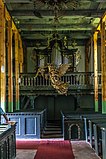 |
I | 9 | Changed several times |
| 1745 | Flemsdorf | Village church | I | 8 | Poorly preserved | |
| 1745–1746 | Ragow (Mittenwalde) | Heilige-Geist-Kirche | I/P | 8 | Not preserved | |
| 1747 | Werben (Elbe) | St. Johannis | 
|
II/P | 27 | Converted to pneumatic by Albert Kohl in 1916, front and 11 stops preserved. Restoration in the spirit of Wagner is planned.[19] |
| 1748 | Berlin | St. Petri | III/P | 50 | Added by Migendt in 1751, lost in fire in 1908 | |
| 1748–1749 | Salzwedel | St. Marien | 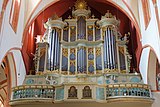
|
III/P | 39 | Completion by Scholtze, front preserved |
References[edit]
- ^ Andreas Kitschke: Der Lehrmeister von Joachim Wagner. In Ars Organi. Vol. 59, 2011, p. 200.
- ^ a b Andreas Kitschke: Der Orgelbauer Joachim Wagner. In Evangelische Kirchengemeinde Schönwalde: Die historische Wagner-Orgel (1739) in der Dorfkirche Schönwalde. Schönwalde-Glien 2015, pp. 10f.
- ^ Christhard Kirchner, Uwe Pape: Joachim Wagner. In Uwe Pape, Wolfram Hackel, Christhard Kirchner (ed.): Lexikon norddeutschet Orgelbauer. Vol. 4. Berlin, Brandenburg and surroundings. Pape Verlag, Berlin 2017. p. 599
- ^ Christhard Kirchner, Uwe Pape: Wagner, Joachim. In: Uwe Pape, Wolfram Hackel, Christhard Kirchner (ed.): Lexikon norddeutscher Orgelbauer. Vol. 4. Berlin, Brandenburg and surroundings. Pape Verlag, Berlin 2017. pp. 599f. with extensive list
- ^ "Joachim Wagner - Werkverzeichnis des Instituts für Orgelforschung Brandenburg". Retrieved 14 February 2021.
- ^ Entwurf Manuskript Institut für Orgelforschung Brandenburg
- ^ Entwurf Institut für Orgelforschung Brandenburg (pdf)
- ^ Foto der historischen Orgel Institut für Orgelforschung Brandenburg
- ^ Orgel in Sternhagen, retrieved 14 February 2021.
- ^ Schinkel und ein Rätseltext von Karl Richter, mit Geschichte und Dispositionen (pdf)
- ^ Foto Institut für Orgelforschung Brandenburg
- ^ Year of implementation after www.garnisonfriedhofberlin.de, retrieved 14 February 2021.
- ^ Orgel in Rühstadt, retrieved 19 February 2021.
- ^ Marie-Luise Buchinger, Marcus Cante: Denkmale in Brandenburg, Landkreis Teltow Fläming, Part 1: Stadt Jüterbog mit Kloster Zinna und Gemeinde Niedergörsdorf. Wernersche Verlagsgesellschaft, ISBN 3-88462-154-8, p. 9.
- ^ Time data according to Nidaros Cathedral: Wagnerorgelet, retrieved 14 February 2021.
- ^ Orgel in Wusterhausen, retrieved 14 February 2021.
- ^ Zeitangabe nach Orgel in Gransee, retrieved 14 February 2021.
- ^ "Restaurierung der Wagner-Transmissionsorgel abgeschlossen" (PDF). Retrieved 14 February 2021.
- ^ www.volksstimme.de: Professor will Werbens Orgel retten, vom 29. November 2017, retrieved 14 February 2021
Further reading[edit]
- Heinz Herbert Steves: Der Orgelbauer Joachim Wagner (1690–1749). In Archiv für Musikforschung 4, 1939, pp. 321–358 and 5, 1940, pp. 17–38. Auch Sonderdruck als Diss. phil. (Cologne 1939): Leipzig 1939.
- Arthur Jaenicke: Der reine Klang. Eine Erzählung aus dem Leben des Orgelbauers Joachim Wagner. Evangelische Verlagsanstalt, Berlin 1957. (With biographical introduction, overview of known Wagner organs and glossary on organ building.)
- Claus-Peter Schulze: Wagner, Joachim. In Die Musik in Geschichte und Gegenwart. Vol. 14, 1968, pp. 77–78.
- Gernot Schmidt: Die Orgeln von Joachim Wagner und ihre Restaurierungen. In The Organ Yearbook. 11, 1980, pp. 31–47.
- Wolf Bergelt: Die Mark Brandenburg. Eine wiederentdeckte Orgellandschaft. Berlin 1989, pp. 15–22 and 104–106.
- Eitelfriedrich Thom (ed.): Der Orgelbauer Joachim Wagner (1690–1749). Michaelstein / Blankenburg 1990.
- Berthold Schwarz (ed.): 500 Jahre Orgeln in Berliner evangelischen Kirchen. Berlin 1991, vol. I, pp. 62–69 and vol. II, pp. 486–488.
- Andreas Kitschke: Die Orgelbauten von Joachim Wagner (1690–1749) in der Residenzstadt Potsdam.In Acta Organologica. 23, 1993, pp. 197–240. [Mit Werkliste und Abbildungen.]
- Wolf Hobohm, Friedrich Wagner: Notizen über einen Hamburger Hauptpastor aus der Sicht der Telemann-Forschung. In Musikkultur in Schlesien zur Zeit von Telemann und Dittersdorf. Sinzig 2001, pp. 129–146.
- Dietrich Kollmannsperger: Wagner, Joachim. In The New Grove Dictionary of Music and Musicians. Vol. 26. 2nd edition. London, New York 2002, p. 974.
- Uwe Czubatynski: Bibliographie zur Geschichte der Orgel in Berlin-Brandenburg. 2., aktualisierte Auflage (elektronische Ressource). Rühstädt 2005.
- Uwe Czubatynski: Geschichte und Restaurierung der Wagner-Orgel in Rühstädt. In Mitteilungen des Verein für Geschichte der Prignitz. 6, 2006, pp. 84–91.
- Wolf Bergelt: Joachim Wagner (1690–1749) Orgelmacher. Schnell und Steiner, Regensburg 2012, ISBN 978-3-7954-2562-3.
- Uwe Czubatynski (2006). "Wagner, Joachim". In Bautz, Traugott (ed.). Biographisch-Bibliographisches Kirchenlexikon (BBKL) (in German). Vol. 26. Nordhausen: Bautz. cols. 1547–1551. ISBN 3-88309-354-8.
